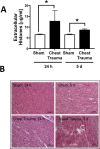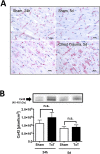Experimental blunt chest trauma-induced myocardial inflammation and alteration of gap-junction protein connexin 43
- PMID: 29121655
- PMCID: PMC5679619
- DOI: 10.1371/journal.pone.0187270
Experimental blunt chest trauma-induced myocardial inflammation and alteration of gap-junction protein connexin 43
Abstract
Objective: Severe blunt chest trauma in humans is associated with high mortality rates. Whereas lung tissue damage and lung inflammation after blunt chest trauma have extensively been investigated, the traumatic and posttraumatic effects on the heart remain poorly understood. Therefore, the purpose of this study was to define cardiac injury patterns in an experimental blunt chest trauma model in rats.
Methods: Experimental blunt chest trauma was induced by a blast wave in rats, with subsequent analysis of its effects on the heart. The animals were subjected either to a sham or trauma procedure. Systemic markers for cardiac injury were determined after 24 h and 5 days. Postmortem analysis of heart tissue addressed structural injury and inflammation 24 h and 5 days after trauma.
Results: Plasma levels of extracellular histones were elevated 24 h and 5 days after blunt chest trauma compared to sham-treated animals. In the heart, up-regulation of interleukin-1β 24 h after trauma and increased myeloperoxidase activity 24 h and 5 days after trauma were accompanied by reduced complement C5a receptor-1 expression 24 h after trauma. Histological analysis revealed extravasation of erythrocytes and immunohistochemical analysis alteration of the pattern of the gap-junction protein connexin 43. Furthermore, a slight reduction of α-actinin and desmin expression in cardiac tissue was found after trauma together with a minor increase in sarcoplasmatic/endoplasmatic reticlulum calcium-ATPase (SERCA) expression.
Conclusions: The clinically highly relevant rat model of blast wave-induced blunt chest trauma is associated with cardiac inflammation and structural alterations in cardiac tissue.
Conflict of interest statement
Figures




Similar articles
-
Structural alterations and inflammation in the heart after multiple trauma followed by reamed versus non-reamed femoral nailing.PLoS One. 2020 Jun 25;15(6):e0235220. doi: 10.1371/journal.pone.0235220. eCollection 2020. PLoS One. 2020. PMID: 32584885 Free PMC article.
-
Cardiac Depression in Pigs after Multiple Trauma - Characterization of Posttraumatic Structural and Functional Alterations.Sci Rep. 2017 Dec 19;7(1):17861. doi: 10.1038/s41598-017-18088-1. Sci Rep. 2017. PMID: 29259232 Free PMC article.
-
Cardiopulmonary, histological, and inflammatory alterations after lung contusion in a novel mouse model of blunt chest trauma.Shock. 2003 Jun;19(6):519-25. doi: 10.1097/01.shk.0000070739.34700.f6. Shock. 2003. PMID: 12785006
-
Mechanisms of remodeling of gap junction distributions and the development of anatomic substrates of arrhythmias.Cardiovasc Res. 1999 May;42(2):309-17. doi: 10.1016/s0008-6363(99)00023-1. Cardiovasc Res. 1999. PMID: 10533569 Review. No abstract available.
-
Left ventricular aneurysm caused by blunt chest trauma.Am J Forensic Med Pathol. 1996 Sep;17(3):194-6. doi: 10.1097/00000433-199609000-00003. Am J Forensic Med Pathol. 1996. PMID: 8870867 Review.
Cited by
-
Early myocardial damage (EMD) and valvular dysfunction after femur fracture in pigs.Sci Rep. 2021 Apr 19;11(1):8503. doi: 10.1038/s41598-021-86151-z. Sci Rep. 2021. PMID: 33875675 Free PMC article.
-
Toll-Like Receptor-Mediated Cardiac Injury during Experimental Sepsis.Mediators Inflamm. 2020 Jan 10;2020:6051983. doi: 10.1155/2020/6051983. eCollection 2020. Mediators Inflamm. 2020. PMID: 32410859 Free PMC article.
-
Systemic and Cardiac Alterations After Long Bone Fracture.Shock. 2020 Dec;54(6):761-773. doi: 10.1097/SHK.0000000000001536. Shock. 2020. PMID: 32205793 Free PMC article.
-
Modeling trauma in rats: similarities to humans and potential pitfalls to consider.J Transl Med. 2019 Sep 5;17(1):305. doi: 10.1186/s12967-019-2052-7. J Transl Med. 2019. PMID: 31488164 Free PMC article. Review.
-
Unintentional weight loss: what radiologists need to know and what clinicians want to know.Abdom Radiol (NY). 2021 May;46(5):2236-2250. doi: 10.1007/s00261-020-02908-6. Epub 2021 Jan 1. Abdom Radiol (NY). 2021. PMID: 33386448 Review.
References
-
- Elie MC. Blunt cardiac injury. Mt Sinai J Med. 2006;73(2):542–52. . - PubMed
-
- Huber S, Biberthaler P, Delhey P, Trentzsch H, Winter H, van Griensven M, et al. Predictors of poor outcomes after significant chest trauma in multiply injured patients: a retrospective analysis from the German Trauma Registry (Trauma Register DGU(R)). Scand J Trauma Resusc Emerg Med. 2014;22(1):52 doi: 10.1186/s13049-014-0052-4 ; PubMed Central PMCID: PMC4347585. - DOI - PMC - PubMed
-
- Huber S, Biberthaler P, Delhey P, Trentzsch H, Winter H, van Griensven M, et al. Predictors of poor outcomes after significant chest trauma in multiply injured patients: a retrospective analysis from the German Trauma Registry (Trauma Register DGU (R)). Scand J Trauma Resus. 2014;22 doi: 10.1186/S13049-014-0052-4 - DOI - PMC - PubMed
-
- Skinner DL, Laing GL, Rodseth RN, Ryan L, Hardcastle TC, Muckart DJ. Blunt cardiac injury in critically ill trauma patients: a single centre experience. Injury. 2015;46(1):66–70. doi: 10.1016/j.injury.2014.08.051 . - DOI - PubMed
-
- Crown LA, Hawkins W. Commotio cordis: Clinical implications of blunt cardiac trauma. American Family Physician. 1997;55(7):2467–70. - PubMed
MeSH terms
Substances
LinkOut - more resources
Full Text Sources
Other Literature Sources
Medical
Research Materials
Miscellaneous

